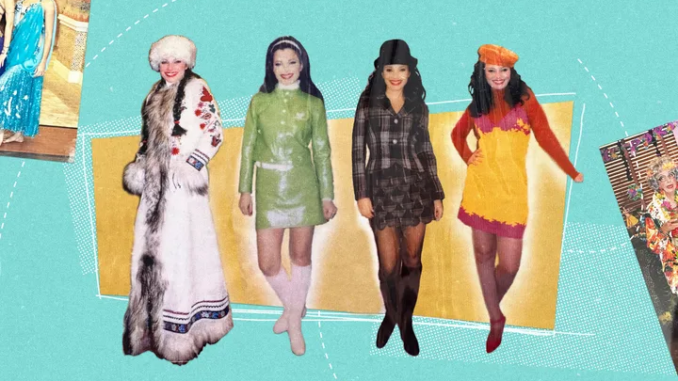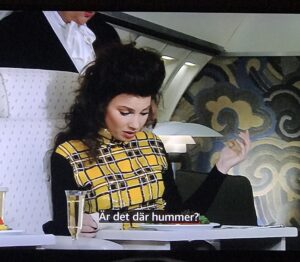
‘The Nanny’ costume designers reflect on the show’s fashion legacy and Fran Drescher’s singular style
“Sassy with a sense of humor, a sense of wit and an underpinning of elegance,” says Emmy Award-winning costume designer Brenda Cooper of Fran Fine’s wardrobe.
On Nov. March 1993, a cosmetics saleswoman from Flushing, Queens rang the doorbell at the Sheffield’s swanky Manhattan residence. Styled effortlessly in a leopard-print suit and suede heels — along with her nasal voice and signature laugh — Fran Fine was fashionable, loud and unapologetically New York.
Portrayed by the inimitable Fran Drescher, The Nanny, centering on a sassy fashionista who becomes a nanny to the three children of a rich English widower, ran for six seasons on CBS, from 1993 to 1999. With her charming wit and exuberant nature, Fran Fine became a ’90s style icon and an unexpected trendsetter for fashion lovers obsessed with her bold, audacious looks.
To ring in the show’s 30th anniversary, Yahoo Entertainment sat down with The Nanny’s costume designers to discuss the show’s enduring legacy and how they created some of the most iconic costumes in television history. Let’s just say, their stories, and archival photos they generously dug up from the vaults, are just as entertaining as the show itself. (Click here to see more behind-the-scenes images from The Nanny.)
Finding Fran: The vest that started it all
Emmy Award-winning costume designer Brenda Cooper was the architect of Fran’s iconic look. She says it all began with a colored-striped vest once worn by supermodel Twiggy on the short-lived series Princesses, which also starred Drescher. Although Cooper was a low-ranking assistant on the 1991 show, Drescher was so impressed by her vision that when it came to finding a costume designer for The Nanny, she knew Cooper was the perfect fit.
“Fran saw something in me and said, ‘I want you to be my designer and I want you to create the look,’” Cooper recalls with a smile. “It was actually my very first job.”
Twiggy’s vest became a building block for what will later come to define Fran’s overall style: “Sassy with a sense of humor, a sense of wit and an underpinning of elegance,” Cooper describes it.

The rest of her silhouette — turtlenecks, strong patterns, black mini skirts, opaque tights and suede high heels — evolved organically throughout the series. For those additions, Cooper was heavily inspired by the work of Edith Head, the Oscar-winning costume designer who helped define the glamor of Hollywood’s Golden Age.
“In a way, Fran was my Barbie doll,” she explained. “Fran let me do my thing, which doesn’t always happen on a set. She basically gave me wings and let me fly.”
Drescher created and executive-produced The Nanny with her then-husband Peter Marc Jacobson, whom Cooper calls the “dream team.” They didn’t expect to set the tone for a new generation of fashion enthusiasts, but as she recalls, it happened anyway. And quickly.
“At the end of the pilot, we knew we had gold,” says Cooper, whose unique approach to fashion inspired her to write the women’s style guidebook The Silhouette Solution. “People weren’t dressing TV stars like this at the time, they just weren’t. When Fran walked out, you knew exactly who she was before she opened her mouth.”
Cooper stayed on the show for the first three seasons, until she left to start a family of her own. That’s when she handed the reins to assistants Shawn-Holly Cookson and Terry Gordon, both of whom carried out Cooper’s vision until the series finale. Needless to say, they had big shoes to fill.
“I was working on the day I was due to deliver [my son],” Cooper shares. “That’s devotion for you.”
‘Oh, my god! She looks fantastic!’
Before she was hired as Cooper’s assistant, Cookson worked mainly on independent films. By the time she took over Cooper’s role in The Nanny’s fourth season, she said it was a well-oiled machine.
“Brenda really sets the tone,” Cookson stresses. “Being my mentor, I really had to make sure to keep the essence of the character.
“We were trying to keep things super interesting without being ridiculous,” she notes of the minor changes that were made here and there over the course of the show. “We struck this balance beautifully with Fran. I think that’s why people resonated with her. With all the bright colors and prints, it could have gone to a place that was like, ‘What are y’all thinking?’ But it never went there. It was always, ‘Oh, my god! She looks fantastic!’”
Jacobson made sure Drescher stood out not just visually, but also energetically, remembers Cookson.
“The way he’d describe it is, if you think of a tree, all the leaves have their own color,” she recalls of a metaphor Jacobson would share as a mental guide. “They look beautiful together, but there’s that one leaf that looks brighter and more beautiful than the others. And that’s Fran.”
